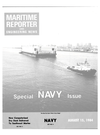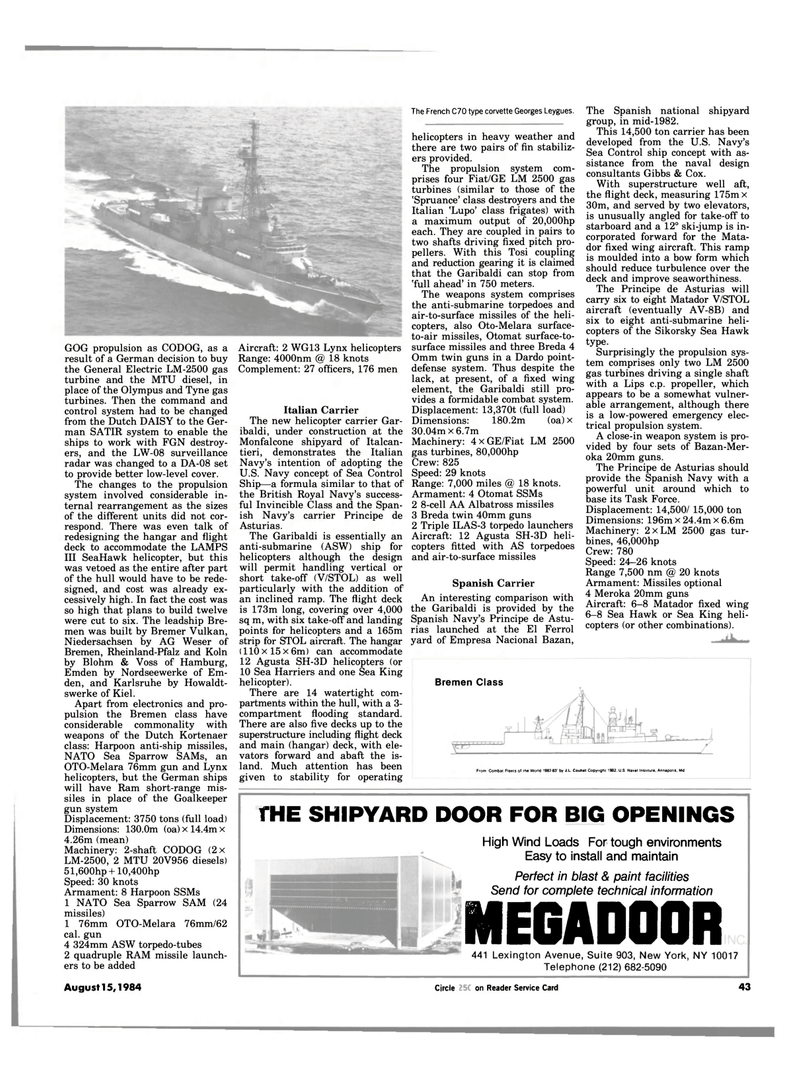
Page 41: of Maritime Reporter Magazine (August 15, 1984)
Read this page in Pdf, Flash or Html5 edition of August 15, 1984 Maritime Reporter Magazine
GOG propulsion as CODOG, as a result of a German decision to buy the General Electric LM-2500 gas turbine and the MTU diesel, in place of the Olympus and Tyne gas turbines. Then the command and control system had to be changed from the Dutch DAISY to the Ger- man SATIR system to enable the ships to work with FGN destroy- ers, and the LW-08 surveillance radar was changed to a DA-08 set to provide better low-level cover.
The changes to the propulsion system involved considerable in- ternal rearrangement as the sizes of the different units did not cor- respond. There was even talk of redesigning the hangar and flight deck to accommodate the LAMPS
III SeaHawk helicopter, but this was vetoed as the entire after part of the hull would have to be rede- signed, and cost was already ex- cessively high. In fact the cost was so high that plans to build twelve were cut to six. The leadship Bre- men was built by Bremer Vulkan,
Niedersachsen by AG Weser of
Bremen, Rheinland-Pfalz and Koln by Blohm & Voss of Hamburg,
Emden by Nordseewerke of Em- den, and Karlsruhe by Howaldt- swerke of Kiel.
Apart from electronics and pro- pulsion the Bremen class have considerable commonality with weapons of the Dutch Kortenaer class: Harpoon anti-ship missiles,
NATO Sea Sparrow SAMs, an
OTO-Melara 76mm gun and Lynx helicopters, but the German ships will have Ram short-range mis- siles in place of the Goalkeeper gun system
Displacement: 3750 tons (full load)
Dimensions: 130.0m (oa) x 14.4m x 4.26m (mean)
Machinery: 2-shaft CODOG (2x
LM-2500, 2 MTU 20V956 diesels) 51,600hp + 10,400hp
Speed: 30 knots
Armament: 8 Harpoon SSMs 1 NATO Sea Sparrow SAM (24 missiles) 1 76mm OTO-Melara 76mm/62 cal. gun 4 324mm ASW torpedo-tubes 2 quadruple RAM missile launch- ers to be added
Aircraft: 2 WG13 Lynx helicopters
Range: 4000nm @ 18 knots
Complement: 27 officers, 176 men
Italian Carrier
The new helicopter carrier Gar- ibaldi, under construction at the
Monfalcone shipyard of Italcan- tieri, demonstrates the Italian
Navy's intention of adopting the
U.S. Navy concept of Sea Control
Ship—a formula similar to that of the British Royal Navy's success- ful Invincible Class and the Span- ish Navy's carrier Principe de
Asturias.
The Garibaldi is essentially an anti-submarine (ASW) ship for helicopters although the design will permit handling vertical or short take-off (V/STOL) as well particularly with the addition of an inclined ramp. The flight deck is 173m long, covering over 4,000 sq m, with six take-off and landing points for helicopters and a 165m strip for STOL aircraft. The hangar (110 x15 x6m) can accommodate 12 Agusta SH-3D helicopters (or 10 Sea Harriers and one Sea King helicopter).
There are 14 watertight com- partments within the hull, with a 3- compartment flooding standard.
There are also five decks up to the superstructure including flight deck and main (hangar) deck, with ele- vators forward and abaft the is- land. Much attention has been given to stability for operating
The French C70 type corvette Georges Leygues. helicopters in heavy weather and there are two pairs of fin stabiliz- ers provided.
The propulsion system com- prises four Fiat/GE LM 2500 gas turbines (similar to those of the 'Spruance' class destroyers and the
Italian 'Lupo' class frigates) with a maximum output of 20,000hp each. They are coupled in pairs to two shafts driving fixed pitch pro- pellers. With this Tosi coupling and reduction gearing it is claimed that the Garibaldi can stop from 'full ahead' in 750 meters.
The weapons system comprises the anti-submarine torpedoes and air-to-surface missiles of the heli- copters, also Oto-Melara surface- to-air missiles, Otomat surface-to- surface missiles and three Breda 4
Omm twin guns in a Dardo point- defense system. Thus despite the lack, at present, of a fixed wing element, the Garibaldi still pro- vides a formidable combat system.
Displacement: 13,370t (full load)
Dimensions: 180.2m (oa) x 30.04m x 6.7m
Machinery: 4xGE/Fiat LM 2500 gas turbines, 80,000hp
Crew: 825
Speed: 29 knots
Range: 7,000 miles @ 18 knots.
Armament: 4 Otomat SSMs 2 8-cell AA Albatross missiles 3 Breda twin 40mm guns 2 Triple ILAS-3 torpedo launchers
Aircraft: 12 Agusta SH-3D heli- copters fitted with AS torpedoes and air-to-surface missiles
Spanish Carrier
An interesting comparison with the Garibaldi is provided by the
Spanish Navy's Principe de Astu- rias launched at the El Ferrol yard of Empresa Nacional Bazan,
The Spanish national shipyard group, in mid-1982.
This 14,500 ton carrier has been developed from the U.S. Navy's
Sea Control ship concept with as- sistance from the naval design consultants Gibbs & Cox.
With superstructure well aft, the flight deck, measuring 175m x 30m, and served by two elevators, is unusually angled for take-off to starboard and a 12° ski-jump is in- corporated forward for the Mata- dor fixed wing aircraft. This ramp is moulded into a bow form which should reduce turbulence over the deck and improve seaworthiness.
The Principe de Asturias will carry six to eight Matador V/STOL aircraft (eventually AV-8B) and six to eight anti-submarine heli- copters of the Sikorsky Sea Hawk type.
Surprisingly the propulsion sys- tem comprises only two LM 2500 gas turbines driving a single shaft with a Lips c.p. propeller, which appears to be a somewhat vulner- able arrangement, although there is a low-powered emergency elec- trical propulsion system.
A close-in weapon system is pro- vided by four sets of Bazan-Mer- oka 20mm guns.
The Principe de Asturias should provide the Spanish Navy with a powerful unit around which to base its Task Force.
Displacement: 14,500/ 15,000 ton
Dimensions: 196m x 24.4m x 6.6m
Machinery: 2xLM 2500 gas tur- bines, 46,000hp
Crew: 780
Speed: 24-26 knots
Range 7,500 nm @ 20 knots
Armament: Missiles optional 4 Meroka 20mm guns
Aircraft: 6-8 Matador fixed wing 6-8 Sea Hawk or Sea King heli- copters (or other combinations).
Bremen Class
From Combat Fleets of Ihe World 1982-83' by J.L. Couhat Copyright 1982, U.S. Naval Institute, Annapolis. Md.
THE DOOR FOR BIG OPENINGS
High Wind Loads For tough environments
Easy to install and maintain
Perfect in blast & paint facilities
Send for complete technical information MEGAD00R 441 Lexington Avenue, Suite 903, New York, NY 10017
Telephone (212) 682-5090
August 15,1984 Circle 317 on Reader Service Card 43

 40
40

 42
42
